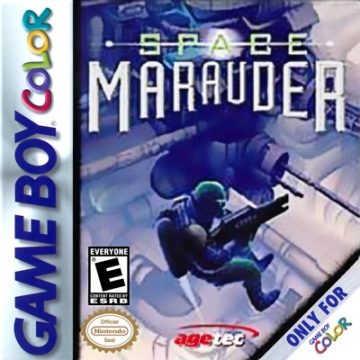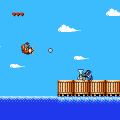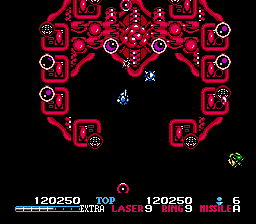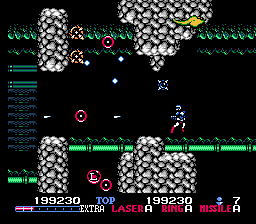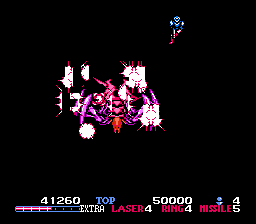KID, standing for “Kindle Imagine Develop,” was a developer who made some pretty decent NES action games, most of which were distributed via Taxan, an American subsidiary of Kaga Electronics. The KID/Taxan combo produced three titles for the NES, listed in reverse release order: G.I. Joe, a surprisingly good game based on Hasbro’s long-standing toyline, Low-G-Man, an unorthodox action-platformer that’s neat if you can dig its odd design, and Burai Fighter, a shoot-em-up which was rather unlike most similar games on the NES library. The majority of classic shooters have you piloting a ship through space or a military aircraft above enemy terrain, while some others just have you as a foot soldier marching through dangerous jungles or deserts or what have you. Burai Fighter is more like Natsume’s SCAT or Capcom’s Forgotten Worlds, where you control a soldier floating through space, here wearing some kind of jetpack suit. (The Japanese cover shows a mecha that looks a whole lot like a Gundam.)
The scant amount of manual story explains that the Burai are super-intelligent and super-malicious extraterrestrials breeding an army of cyborg mutants to rule the universe. That’s as typical a scenario as you can get in this genre, but it’s worth noting that “Burai” is a Hindi word that means “evil.” Seven levels of Burai madness await as you travel through colorful landscapes that exhibit KID’s convention of using every available color palette they can find. While nothing too advanced, the graphics have some interesting background and enemy designs, and the music, by Nobuyuki Shioda, is fitting and occasionally creepy even if not especially notable. If not a fitting candidate for a tech demo, Burai Fighter‘s real meat is its challenging gameplay which requires you to master firing in no less than eight directions instead of just firing to the right or straight up. While your fire control isn’t quite as diverse as in Capcom’s Forgotten Worlds, the ability to shoot in eight directions is necessary for survival as you’ll frequently be scrolling up, left, and down instead of the standard shooter right. Holding the fire button lets you keep firing in one direction and letting go allows you to change, a simple system that has more depth when you factor in the sub-weapons.
You find lots of power-ups that flash between “L” (Laser), “R” (Ring), and “M” (Missile), each granting different boosts to your firepower. The Laser replaces your main gun and acts like the classic Gradius laser, the Ring is fired in tandem with your gun and can pass through walls like the Metroid Wave Beam, and the Missile keeps firing to the right no matter what, like the machine gun in Jackal. If you manage to collect five power-ups of the same type (your count is handily denoted in the lower-right corner), you can also fire your sub-weapon projectile simultaneously behind you. Collecting ten of a power-up fires four projectiles at once, with the Ring shooting a spreadshot, the Missile firing in a constant cross pattern, and the Laser shooting diagonally of your current position which oddly restores your main gun instead of having the Laser overtake it. Getting killed causes the counter for the weapon you were using to reset to zero, though the other two weapons still retain their power levels. Enemies sometimes give off floating gems when destroyed, and collecting enough allows you to drop a screen-clearing Cobalt Bomb. Holding off on using bombs and letting the bomb meter completely fill up actually nets you an extra life. You’ll also find speed-ups and a rotating pod which causes additional damage to enemies in close proximity.
Most of the levels play out as sidescrollers where you go in all sorts of different directions and try not to die against the many flying enemies, turrets, and stage hazards littered about. If you fly around and explore every potential nook, the screen actually scrolls in a different direction than usual and reveals some bonus items that normally would have gone unseen. The manual encourages you to find as many of these “hidden rooms” as possible, and since you don’t blow up on contact with walls, try searching for them when you aren’t mobbed by Burai fire. The end of the normal levels pits you against large bosses with names equally awesome and audacious. The large spider-crustacean thing with rotating tentacles at the end of level one is apparently named the “Giganticrab”, and the dividing worm boss of level two is the “Jawsipede.” The bosses provide fair challenges as they have some tricky attack patterns, but you can shred most of them apart in seconds if you aim true and have a powered sub-weapon. The only one who takes a long time to beat is the final boss, which just so happens to be that rad dragon on the cover art.
Two of the stages, 3 and 6, provide a different style of play which is vaguely reminiscent of Bosconian, or the overhead levels of Contra III. You’re given a vague map screen which shows you and an enemy base in a large square, and you have to try and remember where they’re located when you go into the stage. The perspective is a bird’s-eye view where you can freely roam in any direction while enemies keep rushing at you from offscreen. You need to find the enemy base, presented as a strangely-built fortress with several turrets of which you need to destroy all in classic Compile-boss fashion. These levels can go incredibly fast if you have a decent memory and can take down the base in one swoop, but dying relocates both your position and the base’s, and there’s no clues pointing to the base after the initial mapscreen. These stages are interesting breaks from the main action, though the transition might be a bit odd for some.
Burai Fighter isn’t a very complicated game, and it’s tough for shmups to be innovative over their base premise of “shoot everything,” but it does have just enough elements to make it memorable. The eight-way fire, power-up system, neat bosses, overhead stages, and even the ability to find hidden passages all blend together for a well-designed and quite challenging game. You get three difficulty levels and are only able to see an actual ending on the highest one, which then presents you with an even worse hidden difficulty (a taunting tendency of KID also seen in Low-G-Man). But if you don’t care about that, then don’t worry, as it can still be a tough game on the “easy” Eagle difficulty, yet not brutally so. Burai Fighter is an overlooked gem for the NES that holds testament to the underrated talent of a small developer like KID, and it may be a bit of a small shame they moved away from action games to romance novels that will likely not be fan translated anytime soon.
Burai Fighter was enough of a modest success to receive a Game Boy port titled Burai Fighter Deluxe. “Deluxe” is a bit of an odd misnomer in this case as it’s a scaled-back port, albeit a reasonably faithful one. It has similar levels to the original and the same bosses, but it’s missing the two overhead base-finding levels. Even if you’re not fond of those levels, Deluxe has some rather painful slowdown if the action gets too busy. It’s a decent effort at replicating the original, but it’s completely overshadowed by the Game Boy Color re-release it somehow got several years later. Given the somewhat generic title of Space Marauder in North America (originally just Burai Fighter Color), this version eliminates almost all of the slowdown of the old Game Boy port and the added color actually does look cool. It still doesn’t have the top-down stages, but it’s worth picking up if you like the original enough and/or didn’t care for those levels. There were also plans for a Burai Fighter arcade game, and apparently it was released as a location test, but never received a wide distribution.



